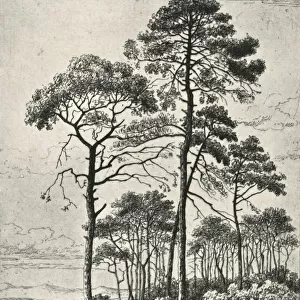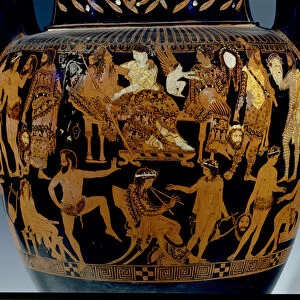Photographic Print > Science Photo Library > History
Photographic Print : Periander, Greek tyrant
![]()

Photo Prints From Science Photo Library
Periander, Greek tyrant
Periander (7th century BCE - 585 BCE), Greek tyrant and one of the Seven Sages of Greece. Periander ruled in the city of Corinth. He oversaw the upgrading of the port there and the construction of a ramp across the Isthmus of Corinth. This was used to drag ships across, using horse-drawn wheeled carriages, a short cut avoiding the long voyage around the Peloponnese islands.. In some ways this could be considered the first form of railway. The revenues were so large that he was able to abolish tax in Corinth. However, Periander was ruthless in protecting his power, killing or banishing anyone who could possibly usurp him. This engraving first appeared in The History of Philosophy by Thomas Stanley, published in London in 1656
Science Photo Library features Science and Medical images including photos and illustrations
Media ID 6316323
© Todd-White Art Photography
1600s 1656 17th Century Drawing Engraving Isthmus Philosopher Philosophy Plate Railway Ramp Ruler Sage Ship Corinth Corinthian Mono Chrome Periander Sages Tyrant
12"x8" Photo Print
Experience the rich history of ancient Greece with our Media Storehouse Photographic Prints. This captivating image of Periander, the enigmatic Greek tyrant, brings the past to life. Taken by the renowned Todd-White Art Photography from Science Photo Library, this print showcases Periander in all his complexity. Rule in the city of Corinth during the 7th century BCE, Periander was one of the Seven Sages of Greece. Add this historic photograph to your collection and let the story of this intriguing figure inspire you every day.
Photo prints are produced on Kodak professional photo paper resulting in timeless and breath-taking prints which are also ideal for framing. The colors produced are rich and vivid, with accurate blacks and pristine whites, resulting in prints that are truly timeless and magnificent. Whether you're looking to display your prints in your home, office, or gallery, our range of photographic prints are sure to impress. Dimensions refers to the size of the paper in inches.
Our Photo Prints are in a large range of sizes and are printed on Archival Quality Paper for excellent colour reproduction and longevity. They are ideal for framing (our Framed Prints use these) at a reasonable cost. Alternatives include cheaper Poster Prints and higher quality Fine Art Paper, the choice of which is largely dependant on your budget.
Estimated Product Size is 20.3cm x 30.5cm (8" x 12")
These are individually made so all sizes are approximate
Artwork printed orientated as per the preview above, with portrait (vertical) orientation to match the source image.
EDITORS COMMENTS
This print depicts Periander, the Greek tyrant and one of the Seven Sages of Greece. Ruling over Corinth in the 7th century BCE, Periander's influence extended far beyond his city-state. Known for his ambitious projects, he oversaw the development of Corinth's port and constructed a remarkable ramp across the Isthmus of Corinth. This ingenious engineering feat allowed ships to be dragged across using horse-drawn wheeled carriages, providing a shortcut that bypassed the arduous voyage around the Peloponnese islands. In many ways, this early form of transportation can be seen as a precursor to railways. Periander's shrewdness was not limited to infrastructure improvements; he also managed to generate substantial revenues from these ventures. The wealth amassed was so significant that he abolished taxes within Corinth, earning him great popularity among its citizens. However, behind this facade of prosperity lay a darker side to Periander's rule. He ruthlessly eliminated anyone who posed even a remote threat to his power through banishment or execution. The engraving featured in this print originates from "The History of Philosophy" by Thomas Stanley published in London in 1656. It offers us an intriguing glimpse into ancient history and reminds us that even those celebrated for their wisdom may possess complex and controversial legacies. Captured beautifully by Todd-White Art Photography, this thought-provoking image invites contemplation on power dynamics, innovation, and human nature
MADE IN THE USA
Safe Shipping with 30 Day Money Back Guarantee
FREE PERSONALISATION*
We are proud to offer a range of customisation features including Personalised Captions, Color Filters and Picture Zoom Tools
SECURE PAYMENTS
We happily accept a wide range of payment options so you can pay for the things you need in the way that is most convenient for you
* Options may vary by product and licensing agreement. Zoomed Pictures can be adjusted in the Basket.














